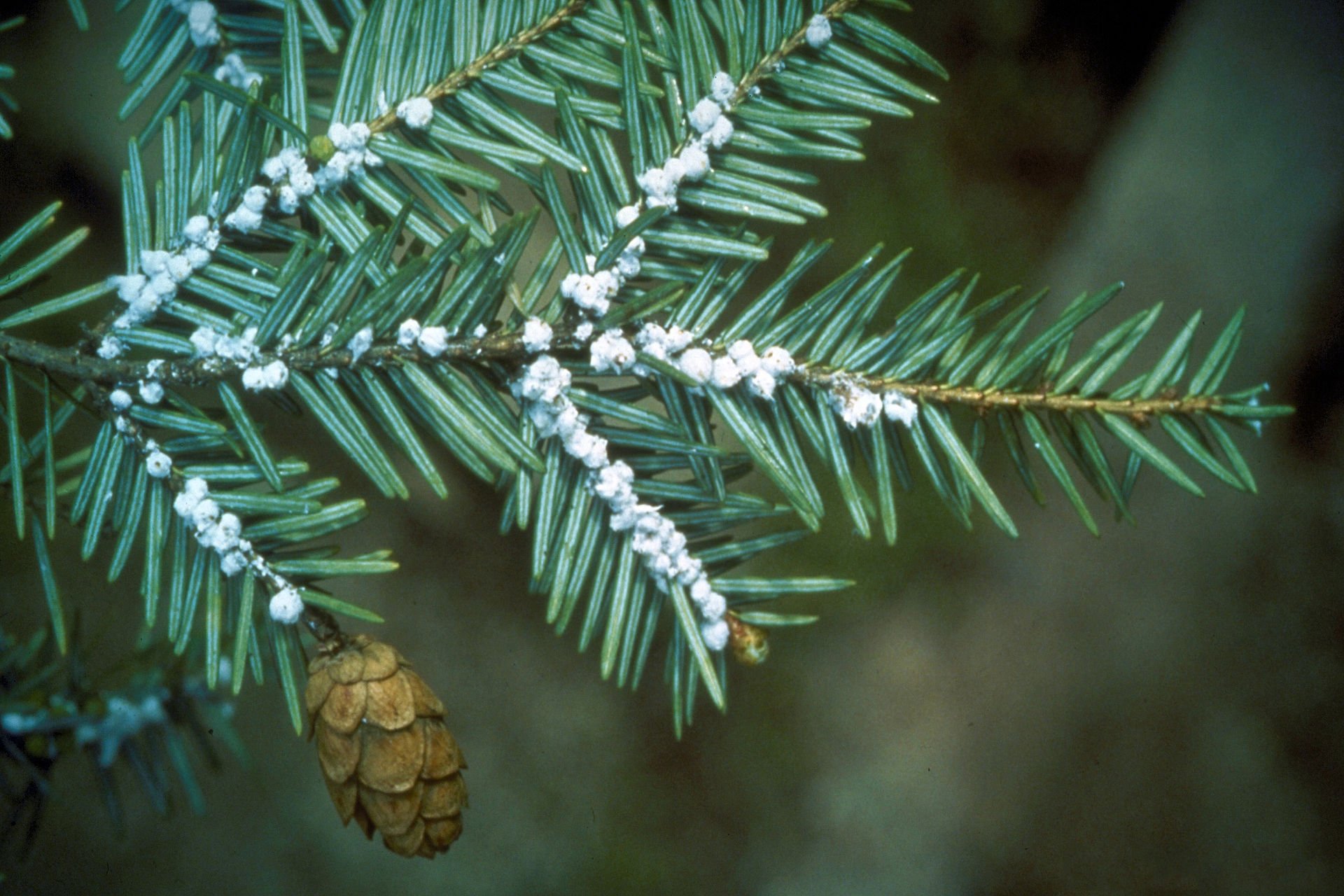eastern Hemlock ID
Eastern Hemlock can be mistaken for other evergreen trees, so to determine if you have hemlocks to protect or a possible infestation it is important to first identify the tree. The needles of Eastern Hemlock grow as singles, rather than in clusters, which can give the branch a “flat” appearance. The needles themselves are about 1/2 inch long and flat with dark green on the top and white stripes on the bottom. If your tree has rounded needles, it is not an Eastern Hemlock. The tree also produces small, papery cones about 3/4 of an inch in length.
Eastern Hemlock needles
Eastern Hemlock cones
Hemlock Woolly ADelgid ID
Below is a brief, helpful video on identifying Hemlock Woolly Adelgid from UMass Amherst:
Hemlock Woolly Adelgid is most easily identified from around November to April, when the white “woolly” masses after which it is named can be found on the undersides of branches near the base of the needles on infested trees. As such, this is the best time of year to look for the pest.
The adelgid can also be seen during the rest of the year but is only present as a small black insect about the size of a sesame seed, which makes it much more difficult to spot.
Other identifying signs for a tree that is infested with HWA are early loss of needles or dead and dying branches. This often leave the tree looking weaker with less foliage and appearing more grayish as opposed to its normal healthy green. Trees with major infestations will also not have any new foliage, which presents as bright green needles on the ends of twigs and branches, in the spring.
Signs of an Infestation (PC: SLELO Prism)
Steps for prevention
Prevention is perhaps the most important step when it comes to a Hemlock Woolly Adelgid infestation, since it can be quite difficult to remove the pest entirely once it has taken root. Precautions taken by individuals in nature are just as important to limiting the spread of HWA as larger management efforts.
Important steps for prevention include:
Active monitoring - Checking your trees regularly for an infestation can help nip any arrivals in the bud. Monitoring should be done at least twice a year, preferably in late March and early November. Early infestations occur on lower branches, and large hemlocks that act as windbreaks may be more likely to get an infestation so could be checked more regularly.
Being aware of your surroundings! - Avoid contact with infested branches or trees to limit transportation, especially from March through July when crawlers can easily become attached and hitch a ride.
Keep birdfeeders far away from hemlocks - Much like people, birds are major spreaders of the adelgid. Keeping birdfeeders away from hemlocks ensures that transmission will not occur this way. This is also especially important during the crawler stage.
Keep hemlocks healthy - Healthy hemlocks are better equipped to fight the adelgid! If you have hemlocks on your property, make sure that they are getting enough water, especially during times of drought. Try to avoid changing drainage patterns near your hemlocks that might cause extra environmental stress.
DO NOT transport infested material - Maine has a mandated quarantine for Hemlock Woolly Adelgid, but regardless it is important to keep an infested material in the area where you found it. This prevents it from spreading easily to a new location.
Clean equipment that has been near HWA - This is especially important from March to July when crawlers can hitch a ride. Equipment can mean clothes or hiking boots, as well as things like ATVs and forestry equipment such as saws.
Avoid excessive fertilizer use - DO NOT fertilize hemlocks near infestation sites. HWA flourishes much faster on fertilized hemlocks, so if there is a strong possibility of local infestation it is important not to fertilize your hemlocks to help them be less susceptible.
REMEMBER: Active monitoring is the best way to prevent the spread of HWA. Catching an infestation early makes treatment much easier, and preventing infestations significantly limits the possibility of spread.
IF YOU HAVE AN INFESTATION, PLEASE REPORT IT TO THE MAINE FOREST SERVICE HERE.
Current Research efforts
Lots of research is being devoted towards understanding Hemlock Woolly Adelgid with a particular focus on prevention and control efforts of the pest. While success has varied, progress is important alongside prevention in terms of ultimately attempting to eradicate HWA.
Biological Controls
Many research efforts have focused on testing different species of natural predator beetles for effective management of HWA populations. This has included species from Asia that naturally control HWA there, like Sasajicymnus tsugae (the tiny lady beetle) from Japan and Scymnus lady beetles from China. Both beetles help stabilize the HWA population, and the tiny lady beetle has been released all along the east coast as a management technique.
Laricobius nigrinus has also been used as a natural beetle predator and can be sourced from its native range in western North America. It is more difficult to support, however, due to requiring more specific rearing conditions in order to be successful.
Because beetles have to be bred and then released, in what is often a very time and resource intensive process, predator control of HWA through this method can be very expensive and is only functional on a wide scale. Many management approaches encourage focusing on shorter-term prevention and management efforts while beetle populations are increased to the point that they may be able to stabilize and prevent HWA on their own.
There is also the potential to use insect-killing fungi to manage HWA populations, but this approach is very much still under development and requires more research to determine if it can be successful.
Hybridization
While the Eastern Hemlock is very susceptible to Hemlock Woolly Adelgid, there are other hemlock species from Asia and western North America that are more resistant to the pest. As a result, some research has gone towards hybridization attempts to crossbreed species like Western Hemlock or Mountain Hemlock with Eastern Hemlock to make a species that is more resistant and that could replace lost Eastern Hemlocks. Unfortunately, hybridization efforts have, so far, proved ineffective for a variety of reasons, including that Western and Mountain Hemlocks and their hybrids have struggled to adapt to the climate on the east coast of North America.
Additional Resources
Michigan Department of Agriculture
SLELO Prism




